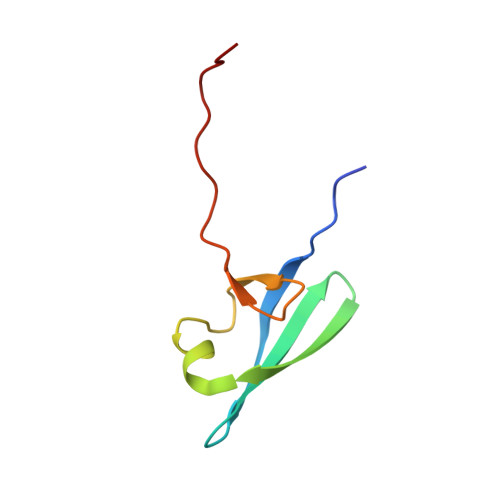De novo design of small beta barrel proteins.
Kim, D.E., Jensen, D.R., Feldman, D., Tischer, D., Saleem, A., Chow, C.M., Li, X., Carter, L., Milles, L., Nguyen, H., Kang, A., Bera, A.K., Peterson, F.C., Volkman, B.F., Ovchinnikov, S., Baker, D.(2023) Proc Natl Acad Sci U S A 120: e2207974120-e2207974120
- PubMed: 36897987
- DOI: https://doi.org/10.1073/pnas.2207974120
- Primary Citation of Related Structures:
7UR7, 7UR8, 7UWY, 7UWZ - PubMed Abstract:
Small beta barrel proteins are attractive targets for computational design because of their considerable functional diversity despite their very small size (<70 amino acids). However, there are considerable challenges to designing such structures, and there has been little success thus far. Because of the small size, the hydrophobic core stabilizing the fold is necessarily very small, and the conformational strain of barrel closure can oppose folding; also intermolecular aggregation through free beta strand edges can compete with proper monomer folding. Here, we explore the de novo design of small beta barrel topologies using both Rosetta energy-based methods and deep learning approaches to design four small beta barrel folds: Src homology 3 (SH3) and oligonucleotide/oligosaccharide-binding (OB) topologies found in nature and five and six up-and-down-stranded barrels rarely if ever seen in nature. Both approaches yielded successful designs with high thermal stability and experimentally determined structures with less than 2.4 Å rmsd from the designed models. Using deep learning for backbone generation and Rosetta for sequence design yielded higher design success rates and increased structural diversity than Rosetta alone. The ability to design a large and structurally diverse set of small beta barrel proteins greatly increases the protein shape space available for designing binders to protein targets of interest.
- Department of Biochemistry, University of Washington, Seattle, WA 98195.
Organizational Affiliation:
















